Просмотров: 4 517
The Global Rheumatologic Tests. Version 2.0.
Candidate of Medicine Khanov A. G.
The article is devoted to physical examination of bones, joints and muscles in outpatient practice for doctors of any specialty. The article offers working classification of methods of evaluation of moving function of joints, tests of physical examination with articulate syndrome. It gives definition of global rheumatologic tests. The article offers a set of screening tests for diagnosing of pathology of the musculoskeletal system and particular areas of a human body for establishing provisional rheumatologic (working) diagnosis. Interpretation of the results of examination is also given here.
Key Words: rheumatology, physical examination of joints in outpatient practice, classification of methods of evaluation of moving function of joints, classification of tests of physical examination of bones, joints and muscles, definition of conception global tests in rheumatology, a set of global rheumatologic tests for provisional rheumatologic diagnosis and interpretation of the results of examination.
Working Classification of Methods of Evaluation of Moving Function of Joints in Outpatient Practice.
1. Examination or visual perception of skeleton and certain joints functions
2. Doing of active and passive movements
3. Functional examination with the help of trials and tests
4. How to estimate the dimension of movement of joints with the help of goniometer (flex meter)
Working Classification of Tests of Physical Examination of Bones, Joints and Muscles
1. Global Tests
Global test (GT) is a general comprehensive test, research, trial, check.
Global tests are tentative screening tests for a certain area or the whole musculoskeletal system of a human body. Doing simple stereotyped movements (bending, squatting) in a certain plane or while passing a certain point in these tests is
provocative for emergence of a pain syndrome in a certain group of joints or indicating to the area which demands additional examination to define the type of affection of a joint (joints) and establish provisional rheumatologic (working) diagnosis.
*Before establishing the cause of pain on the basis of global tests one can say about the pain in a certain area of a body in the area of a certain joint which can be caused by pathology of the joint structures, periarticular tissues or be a reflected pain.
1. Functional Tests of damaging joints, tendons and muscles.
2. Provocative Tests.
Provocation (lat. provocatio) – in medicine action as a diagnostic maneuver leading to a disease state.
3. Stress Test (STT) – load trials, tests in a heavy-weight regimen, trials with additional loads or stress
4. Screening Tests (SCT) – (Eng. Screening, screen – sift, sort) in medicine mass examination for detection a person’s particular disease or symptom.
5. Tests of examination of particular areas of a body, joints and parts of the skeleton (purposeful, problem-oriented)
6.1 Tests on inflammation of joints, periarticular tissues and articular corpuscles.
6.2 Tests of stability of joints and particular joints.
6.3 Tests of estimation of a moving function of joints ( Doing of active and passive movements)
6.4 Tests of compression of nerves.
6.5 Tests of annoyance of nerves.
6.6 Traction muscle tests.
6.7 Isometric (while contraction of muscles without changing of their length) tests. (Tests with “résistance”, “Resistive” tests).
6.8 Combined tests.
General Examination of the Body
Diagnostic Purpose: To estimate height, mass of a body, length and size of a trunk and limbs, their ratio, form of a column and limbs.
To form the view about physical development, carriage, gait of a patient.
To pay attention to the usage by the sick of assistants of movement and support (a stick, crutches, a chair, relations or medical staff’s help)
Demand: examination is held in “anatomical position”. The body is vertical. Feet are joined across. Arms are dropped along the trunk, palms are outside.
Comment. This position is unusual for a person, but it is simple initial for making movements.
 Pic.1 “Anatomic position”
Global Tests
Pic.1 “Anatomic position”
Global Tests
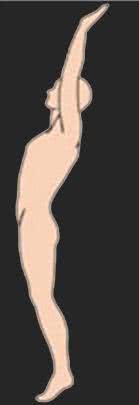 Pic.1.1 Test on straightening. Demand: To pull arms, legs and back upwards as much as possible.
Pic.1.1 Test on straightening. Demand: To pull arms, legs and back upwards as much as possible.
 Pic.1.2 Test in the squatting position. Demand: To sit in the squatting position as low as possible, feet are closely pressed to the floor, head is between knees, arms are bent.
Pic.1.2 Test in the squatting position. Demand: To sit in the squatting position as low as possible, feet are closely pressed to the floor, head is between knees, arms are bent.
 Pic1.3 Global test of maximum bending down. Demand: To bend down as much as possible without flexing knees and without coming feet off the floor and try to touch the floor. Hands hang freely in the same distance from feet.
Explanation of results: This test characterizes total mobility of movements of a
Spinal column which can be reached for account of movements of a column and hip joints. Stiffness of a column can be compensated by sufficient amplitude of movements in hip joints. If you look from one side you can estimate the angulations for account of hip joints and the angulations of the whole trunk. The first angle is acute, tending to the right one. The second angle has a ceiling value while fingers are touching the floor.
Pic1.3 Global test of maximum bending down. Demand: To bend down as much as possible without flexing knees and without coming feet off the floor and try to touch the floor. Hands hang freely in the same distance from feet.
Explanation of results: This test characterizes total mobility of movements of a
Spinal column which can be reached for account of movements of a column and hip joints. Stiffness of a column can be compensated by sufficient amplitude of movements in hip joints. If you look from one side you can estimate the angulations for account of hip joints and the angulations of the whole trunk. The first angle is acute, tending to the right one. The second angle has a ceiling value while fingers are touching the floor.
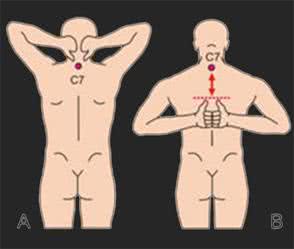 Pic1.4 Global test with pain in the shoulder (A fast test of a combined movement)
Diagnostic Purpose: To estimate the function of joints of a shoulder girdle and partially of an elbow joint.
Explanation of results: The onset of the pain while examining and/or the restriction of movement volume reflects a pathologic process either in the shoulder girdle or in the rotatable cuff (muscles, joints of supraspinous, infraspinatus and small round muscles).
Pic1.4 Global test with pain in the shoulder (A fast test of a combined movement)
Diagnostic Purpose: To estimate the function of joints of a shoulder girdle and partially of an elbow joint.
Explanation of results: The onset of the pain while examining and/or the restriction of movement volume reflects a pathologic process either in the shoulder girdle or in the rotatable cuff (muscles, joints of supraspinous, infraspinatus and small round muscles).
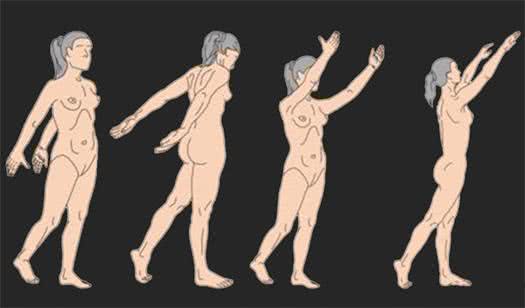 Pic.1.5 Global Test for girdles (shoulder and pelvic) of the trunk and extremities (upper and lower).
Demand: The test must be done from anatomical position. Firstly, antepulsion of arms is done simultaneously in the shoulder (bending, inclination of upper extremities in the frontal plane to an angle of 45 degrees). The next step is retropulsion (abduction back. The movement of the hip – elongation (a step backward) is made simultaneously in turn. (Pic.1.5 A.B.)
Comment. The test can be divided into 2 parts: first, for upper and then for lower extremities. The step backward can be replaced with hip bending (Pic.1.5 C.D.)
Pic.1.5 Global Test for girdles (shoulder and pelvic) of the trunk and extremities (upper and lower).
Demand: The test must be done from anatomical position. Firstly, antepulsion of arms is done simultaneously in the shoulder (bending, inclination of upper extremities in the frontal plane to an angle of 45 degrees). The next step is retropulsion (abduction back. The movement of the hip – elongation (a step backward) is made simultaneously in turn. (Pic.1.5 A.B.)
Comment. The test can be divided into 2 parts: first, for upper and then for lower extremities. The step backward can be replaced with hip bending (Pic.1.5 C.D.)
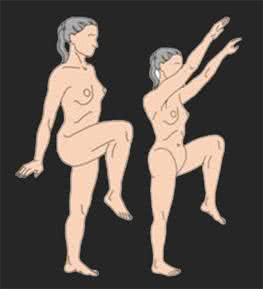 Pic.1.6. Global test of flexibility of the foot (Test of the foot roll from the heel to the toe and the contact of the toes with the floor).
Pic.1.6. Global test of flexibility of the foot (Test of the foot roll from the heel to the toe and the contact of the toes with the floor).
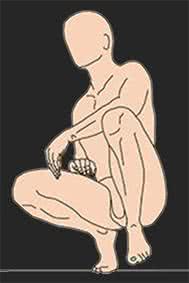 Demand: By turns the sick makes the roll on the toe for each foot from the position of the support on the heel and then leans on the tiptoes with the weight of his body.
Pic. 1.7. Globalmuscletests.(Functional muscle tests.Resistance muscle test.)
Diagnostic target: Examination of the patient with general myalgia. Muscle weakness tests.
Requirement: In the process of the functional muscle test the patient stands up from the “sitting” position, hands folded in front of the body. Pic. 1.7.A.
Demand: By turns the sick makes the roll on the toe for each foot from the position of the support on the heel and then leans on the tiptoes with the weight of his body.
Pic. 1.7. Globalmuscletests.(Functional muscle tests.Resistance muscle test.)
Diagnostic target: Examination of the patient with general myalgia. Muscle weakness tests.
Requirement: In the process of the functional muscle test the patient stands up from the “sitting” position, hands folded in front of the body. Pic. 1.7.A.
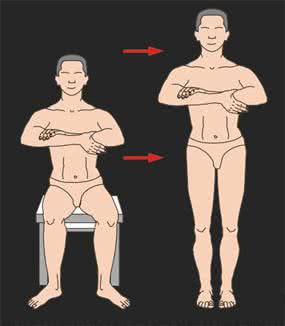 The patient sits from the “lying” position, hands folded in front of the body. Pic. 1.7.Б.
The patient sits from the “lying” position, hands folded in front of the body. Pic. 1.7.Б.
 During the resistance tests the patient keeps his arms pulled, resisting pressure of the doctor’s arm. Pic. 1.7.B.
During the resistance tests the patient keeps his arms pulled, resisting pressure of the doctor’s arm. Pic. 1.7.B.
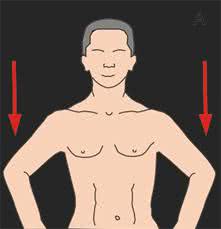 The patient lifts his head and neck with resistance while pressure is applied to his forehead.Pic.1.7.Г.
The patient lifts his head and neck with resistance while pressure is applied to his forehead.Pic.1.7.Г.
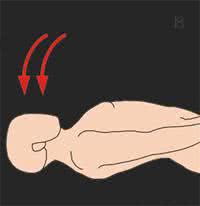 The patient overcomes resistance of the doctor’s arms with pressure applied to the lower part of the hip. Pic.1.7.Д.
The patient overcomes resistance of the doctor’s arms with pressure applied to the lower part of the hip. Pic.1.7.Д.
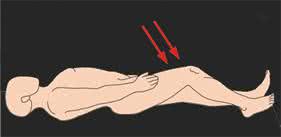 Interpretation of the results: Myalgia andmuscle weakness are not considered to be a symptom specific for a certain disease. Pain and weakness in muscles are observed in neurological conditions (progressive muscular atrophy, myasthenia), vascular diseases with ischemia of major vessels and thyroid gland pathology (endocrine myopathy). In cases of rheumatic diseases the general myalgia is observed with fibromyalgia, polymyalgia rheumatic. Muscle weakness is a main symptom of poly/dermatomyositis. Cases of myositis are also registered with Sjogren’s syndrome, sclerodermia, systemic lupus erythematosus.
Pic. 1.8. Global joint hypermobility tests
Diagnostic target:Joint hypermobility screening examination.
Notes.Hypermobility can be measured in points. Maximum number of points – 9.
Interpretation of the results: Myalgia andmuscle weakness are not considered to be a symptom specific for a certain disease. Pain and weakness in muscles are observed in neurological conditions (progressive muscular atrophy, myasthenia), vascular diseases with ischemia of major vessels and thyroid gland pathology (endocrine myopathy). In cases of rheumatic diseases the general myalgia is observed with fibromyalgia, polymyalgia rheumatic. Muscle weakness is a main symptom of poly/dermatomyositis. Cases of myositis are also registered with Sjogren’s syndrome, sclerodermia, systemic lupus erythematosus.
Pic. 1.8. Global joint hypermobility tests
Diagnostic target:Joint hypermobility screening examination.
Notes.Hypermobility can be measured in points. Maximum number of points – 9.
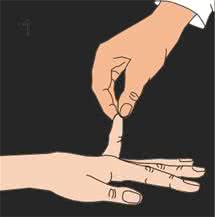 Requirement: Unbend the little finder in the metacarpophalangeal joint at more than 900(1 point for each side). Pic. 1.8.1.
Requirement: Unbend the little finder in the metacarpophalangeal joint at more than 900(1 point for each side). Pic. 1.8.1.
 Requirement: Bend the thumbtowards the wrist until it touches the forearm(1 point for each side). Pic. 1.8.2.
Requirement: Bend the thumbtowards the wrist until it touches the forearm(1 point for each side). Pic. 1.8.2.
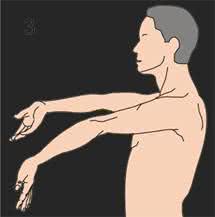 Requirement: Unbend the elbow joints for more than 100(1 point for each side). Pic. 1.8.3.
Requirement: Unbend the elbow joints for more than 100(1 point for each side). Pic. 1.8.3.
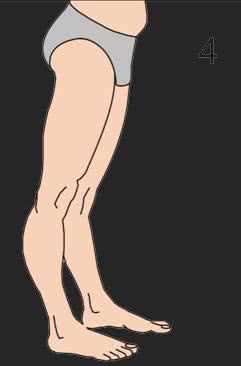 Requirement: Unbend the knee joints for more than 100(1 point for each side). Pic. 1.8.4.
Requirement: Unbend the knee joints for more than 100(1 point for each side). Pic. 1.8.4.
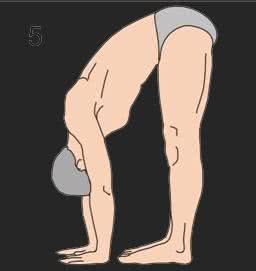 Requirement:Touch the floor with your hands without knees bending (1 point). Pic. 1.8.5.
Interpretation of the results:Hypermobility can cause injuries of joints and soft tissues. In most cases this condition is asymptomatic. Some patients can feel pain in joints. However, it is not associated with rheumatic inflammation and arthrosis. The benign joint hypermobility syndrome is a risk factor of subluxations, repetitive joint microtraumas, tension of ligaments and joint capsules, musculoskeletal pains with formation of points and knots of tenderness. Joint hypermobility diagnostics is obligatory for systematic strengthening of ligamental and muscular systems with exercise therapy.
Notes. Patients with the hypermobility syndrome have associated signs of connective tissue dysplasia. Striate atrophy and pathologic scars are observed on the skin. Eyes: eyelid droop (ptosis), myopathy, medial strabismus. Patients complain of long-lasting arthralgia, they suffer from recurred dislocation,proctoptosia (procidentia) is possible. Other clinical signs are varix dilatation, tendency to recurrent soft tissues injuries after trivial traumas. Patients may have a marfanoid body shape when the span is larger than the patient’s height.
Requirement:Touch the floor with your hands without knees bending (1 point). Pic. 1.8.5.
Interpretation of the results:Hypermobility can cause injuries of joints and soft tissues. In most cases this condition is asymptomatic. Some patients can feel pain in joints. However, it is not associated with rheumatic inflammation and arthrosis. The benign joint hypermobility syndrome is a risk factor of subluxations, repetitive joint microtraumas, tension of ligaments and joint capsules, musculoskeletal pains with formation of points and knots of tenderness. Joint hypermobility diagnostics is obligatory for systematic strengthening of ligamental and muscular systems with exercise therapy.
Notes. Patients with the hypermobility syndrome have associated signs of connective tissue dysplasia. Striate atrophy and pathologic scars are observed on the skin. Eyes: eyelid droop (ptosis), myopathy, medial strabismus. Patients complain of long-lasting arthralgia, they suffer from recurred dislocation,proctoptosia (procidentia) is possible. Other clinical signs are varix dilatation, tendency to recurrent soft tissues injuries after trivial traumas. Patients may have a marfanoid body shape when the span is larger than the patient’s height.
 Pic.1 “Anatomic position”
Global Tests
Pic.1 “Anatomic position”
Global Tests
 Pic.1.1 Test on straightening. Demand: To pull arms, legs and back upwards as much as possible.
Pic.1.1 Test on straightening. Demand: To pull arms, legs and back upwards as much as possible.
 Pic.1.2 Test in the squatting position. Demand: To sit in the squatting position as low as possible, feet are closely pressed to the floor, head is between knees, arms are bent.
Pic.1.2 Test in the squatting position. Demand: To sit in the squatting position as low as possible, feet are closely pressed to the floor, head is between knees, arms are bent.
 Pic1.3 Global test of maximum bending down. Demand: To bend down as much as possible without flexing knees and without coming feet off the floor and try to touch the floor. Hands hang freely in the same distance from feet.
Explanation of results: This test characterizes total mobility of movements of a
Spinal column which can be reached for account of movements of a column and hip joints. Stiffness of a column can be compensated by sufficient amplitude of movements in hip joints. If you look from one side you can estimate the angulations for account of hip joints and the angulations of the whole trunk. The first angle is acute, tending to the right one. The second angle has a ceiling value while fingers are touching the floor.
Pic1.3 Global test of maximum bending down. Demand: To bend down as much as possible without flexing knees and without coming feet off the floor and try to touch the floor. Hands hang freely in the same distance from feet.
Explanation of results: This test characterizes total mobility of movements of a
Spinal column which can be reached for account of movements of a column and hip joints. Stiffness of a column can be compensated by sufficient amplitude of movements in hip joints. If you look from one side you can estimate the angulations for account of hip joints and the angulations of the whole trunk. The first angle is acute, tending to the right one. The second angle has a ceiling value while fingers are touching the floor.
 Pic1.4 Global test with pain in the shoulder (A fast test of a combined movement)
Diagnostic Purpose: To estimate the function of joints of a shoulder girdle and partially of an elbow joint.
Explanation of results: The onset of the pain while examining and/or the restriction of movement volume reflects a pathologic process either in the shoulder girdle or in the rotatable cuff (muscles, joints of supraspinous, infraspinatus and small round muscles).
Pic1.4 Global test with pain in the shoulder (A fast test of a combined movement)
Diagnostic Purpose: To estimate the function of joints of a shoulder girdle and partially of an elbow joint.
Explanation of results: The onset of the pain while examining and/or the restriction of movement volume reflects a pathologic process either in the shoulder girdle or in the rotatable cuff (muscles, joints of supraspinous, infraspinatus and small round muscles).
- A. The capture of the occiput ( Test “Putting hands behind the head”)
- B. The capture “Knot” ( Test “Putting hands behind the back”)
 Pic.1.5 Global Test for girdles (shoulder and pelvic) of the trunk and extremities (upper and lower).
Demand: The test must be done from anatomical position. Firstly, antepulsion of arms is done simultaneously in the shoulder (bending, inclination of upper extremities in the frontal plane to an angle of 45 degrees). The next step is retropulsion (abduction back. The movement of the hip – elongation (a step backward) is made simultaneously in turn. (Pic.1.5 A.B.)
Comment. The test can be divided into 2 parts: first, for upper and then for lower extremities. The step backward can be replaced with hip bending (Pic.1.5 C.D.)
Pic.1.5 Global Test for girdles (shoulder and pelvic) of the trunk and extremities (upper and lower).
Demand: The test must be done from anatomical position. Firstly, antepulsion of arms is done simultaneously in the shoulder (bending, inclination of upper extremities in the frontal plane to an angle of 45 degrees). The next step is retropulsion (abduction back. The movement of the hip – elongation (a step backward) is made simultaneously in turn. (Pic.1.5 A.B.)
Comment. The test can be divided into 2 parts: first, for upper and then for lower extremities. The step backward can be replaced with hip bending (Pic.1.5 C.D.)
 Pic.1.6. Global test of flexibility of the foot (Test of the foot roll from the heel to the toe and the contact of the toes with the floor).
Pic.1.6. Global test of flexibility of the foot (Test of the foot roll from the heel to the toe and the contact of the toes with the floor).
 Demand: By turns the sick makes the roll on the toe for each foot from the position of the support on the heel and then leans on the tiptoes with the weight of his body.
Pic. 1.7. Globalmuscletests.(Functional muscle tests.Resistance muscle test.)
Diagnostic target: Examination of the patient with general myalgia. Muscle weakness tests.
Requirement: In the process of the functional muscle test the patient stands up from the “sitting” position, hands folded in front of the body. Pic. 1.7.A.
Demand: By turns the sick makes the roll on the toe for each foot from the position of the support on the heel and then leans on the tiptoes with the weight of his body.
Pic. 1.7. Globalmuscletests.(Functional muscle tests.Resistance muscle test.)
Diagnostic target: Examination of the patient with general myalgia. Muscle weakness tests.
Requirement: In the process of the functional muscle test the patient stands up from the “sitting” position, hands folded in front of the body. Pic. 1.7.A.
 The patient sits from the “lying” position, hands folded in front of the body. Pic. 1.7.Б.
The patient sits from the “lying” position, hands folded in front of the body. Pic. 1.7.Б.
 During the resistance tests the patient keeps his arms pulled, resisting pressure of the doctor’s arm. Pic. 1.7.B.
During the resistance tests the patient keeps his arms pulled, resisting pressure of the doctor’s arm. Pic. 1.7.B.
 The patient lifts his head and neck with resistance while pressure is applied to his forehead.Pic.1.7.Г.
The patient lifts his head and neck with resistance while pressure is applied to his forehead.Pic.1.7.Г.
 The patient overcomes resistance of the doctor’s arms with pressure applied to the lower part of the hip. Pic.1.7.Д.
The patient overcomes resistance of the doctor’s arms with pressure applied to the lower part of the hip. Pic.1.7.Д.
 Interpretation of the results: Myalgia andmuscle weakness are not considered to be a symptom specific for a certain disease. Pain and weakness in muscles are observed in neurological conditions (progressive muscular atrophy, myasthenia), vascular diseases with ischemia of major vessels and thyroid gland pathology (endocrine myopathy). In cases of rheumatic diseases the general myalgia is observed with fibromyalgia, polymyalgia rheumatic. Muscle weakness is a main symptom of poly/dermatomyositis. Cases of myositis are also registered with Sjogren’s syndrome, sclerodermia, systemic lupus erythematosus.
Pic. 1.8. Global joint hypermobility tests
Diagnostic target:Joint hypermobility screening examination.
Notes.Hypermobility can be measured in points. Maximum number of points – 9.
Interpretation of the results: Myalgia andmuscle weakness are not considered to be a symptom specific for a certain disease. Pain and weakness in muscles are observed in neurological conditions (progressive muscular atrophy, myasthenia), vascular diseases with ischemia of major vessels and thyroid gland pathology (endocrine myopathy). In cases of rheumatic diseases the general myalgia is observed with fibromyalgia, polymyalgia rheumatic. Muscle weakness is a main symptom of poly/dermatomyositis. Cases of myositis are also registered with Sjogren’s syndrome, sclerodermia, systemic lupus erythematosus.
Pic. 1.8. Global joint hypermobility tests
Diagnostic target:Joint hypermobility screening examination.
Notes.Hypermobility can be measured in points. Maximum number of points – 9.
 Requirement: Unbend the little finder in the metacarpophalangeal joint at more than 900(1 point for each side). Pic. 1.8.1.
Requirement: Unbend the little finder in the metacarpophalangeal joint at more than 900(1 point for each side). Pic. 1.8.1.
 Requirement: Bend the thumbtowards the wrist until it touches the forearm(1 point for each side). Pic. 1.8.2.
Requirement: Bend the thumbtowards the wrist until it touches the forearm(1 point for each side). Pic. 1.8.2.
 Requirement: Unbend the elbow joints for more than 100(1 point for each side). Pic. 1.8.3.
Requirement: Unbend the elbow joints for more than 100(1 point for each side). Pic. 1.8.3.
 Requirement: Unbend the knee joints for more than 100(1 point for each side). Pic. 1.8.4.
Requirement: Unbend the knee joints for more than 100(1 point for each side). Pic. 1.8.4.
 Requirement:Touch the floor with your hands without knees bending (1 point). Pic. 1.8.5.
Interpretation of the results:Hypermobility can cause injuries of joints and soft tissues. In most cases this condition is asymptomatic. Some patients can feel pain in joints. However, it is not associated with rheumatic inflammation and arthrosis. The benign joint hypermobility syndrome is a risk factor of subluxations, repetitive joint microtraumas, tension of ligaments and joint capsules, musculoskeletal pains with formation of points and knots of tenderness. Joint hypermobility diagnostics is obligatory for systematic strengthening of ligamental and muscular systems with exercise therapy.
Notes. Patients with the hypermobility syndrome have associated signs of connective tissue dysplasia. Striate atrophy and pathologic scars are observed on the skin. Eyes: eyelid droop (ptosis), myopathy, medial strabismus. Patients complain of long-lasting arthralgia, they suffer from recurred dislocation,proctoptosia (procidentia) is possible. Other clinical signs are varix dilatation, tendency to recurrent soft tissues injuries after trivial traumas. Patients may have a marfanoid body shape when the span is larger than the patient’s height.
Requirement:Touch the floor with your hands without knees bending (1 point). Pic. 1.8.5.
Interpretation of the results:Hypermobility can cause injuries of joints and soft tissues. In most cases this condition is asymptomatic. Some patients can feel pain in joints. However, it is not associated with rheumatic inflammation and arthrosis. The benign joint hypermobility syndrome is a risk factor of subluxations, repetitive joint microtraumas, tension of ligaments and joint capsules, musculoskeletal pains with formation of points and knots of tenderness. Joint hypermobility diagnostics is obligatory for systematic strengthening of ligamental and muscular systems with exercise therapy.
Notes. Patients with the hypermobility syndrome have associated signs of connective tissue dysplasia. Striate atrophy and pathologic scars are observed on the skin. Eyes: eyelid droop (ptosis), myopathy, medial strabismus. Patients complain of long-lasting arthralgia, they suffer from recurred dislocation,proctoptosia (procidentia) is possible. Other clinical signs are varix dilatation, tendency to recurrent soft tissues injuries after trivial traumas. Patients may have a marfanoid body shape when the span is larger than the patient’s height. 

